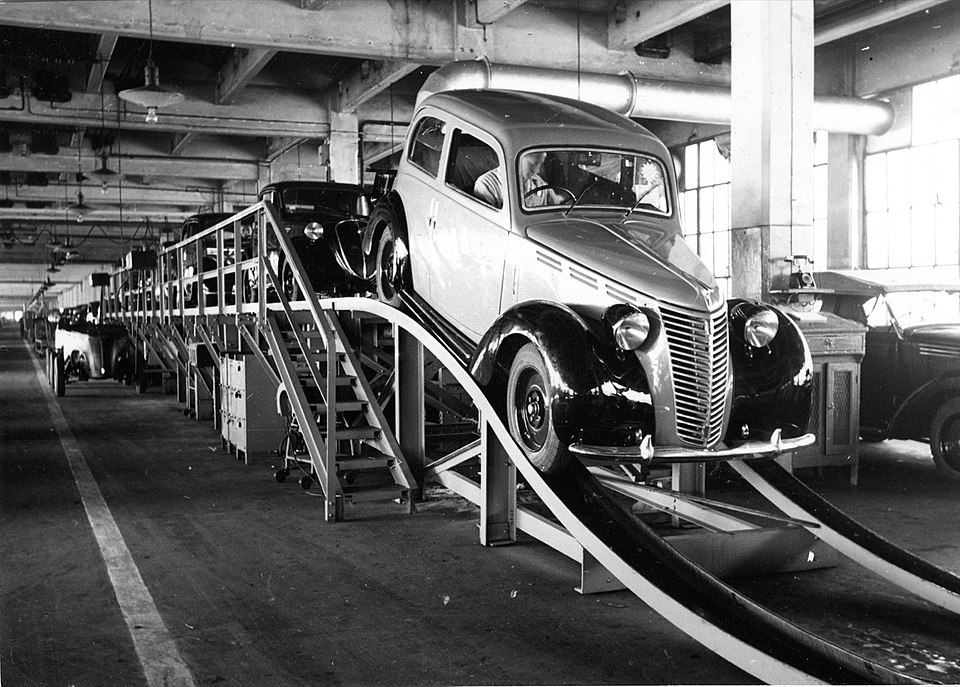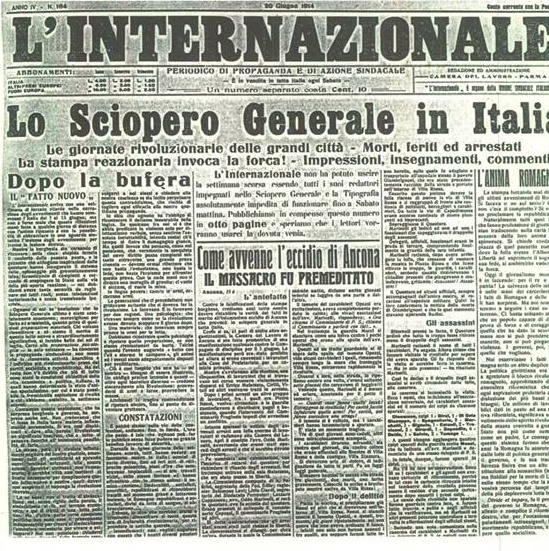OCR Specification focus:
‘industrial growth and its consequence, violence and strikes; Giolitti’s ministries’
Italy between 1896 and 1915 experienced dramatic industrial transformation, intense labour unrest, and the reformist yet fragile leadership of Giovanni Giolitti, who attempted to balance competing interests.
Industrial Growth in Early Twentieth-Century Italy
By the turn of the century, Italy’s economy began to modernise unevenly. Northern cities like Milan, Turin, and Genoa became the heart of industrialisation, particularly in steel, textiles, and the nascent motor industry.
Features of Industrial Expansion
Rapid growth in heavy industry centred on the north-west.
Development of hydroelectric power to fuel factories.
Expansion of railways and infrastructure to link urban centres.
Emergence of companies such as FIAT, founded in 1899, as symbols of modern Italy.

Assembly line inside FIAT’s Lingotto plant in Turin, showing mass production of the Fiat 1100. Though photographed in 1939, it exemplifies the motor industry’s rapid expansion that began in the pre-war Giolittian era. Source
Despite these advances, the Mezzogiorno (southern Italy) remained largely agrarian and impoverished, deepening the economic divide within the nation.
Industrialisation: The process by which an economy is transformed from primarily agricultural to one based on the manufacturing of goods and services.
This uneven development created significant regional tensions that shaped both politics and society.
Consequences of Industrial Growth
Industrialisation brought profound social consequences. The new industrial working class faced long hours, poor pay, and unsafe working conditions.
Labour Unrest
Strikes became increasingly common in the northern industrial centres.
Growth of trade unions and socialist organisations demanding better rights.
Strikes sometimes escalated into violent clashes between workers and the police.
Between 1901 and 1911, the number of strikes rose sharply, reflecting the radicalisation of the working class.

Front page of L’Internazionale highlighting the Red Week of June 1914, when strikes and riots spread across Romagna and the Marche. This contemporary press source illustrates how labour militancy culminated in nationwide unrest at the end of the Giolittian period. The image is a clean newspaper page and includes the period headline “Settimana Rossa.” Source
Socialism and Political Pressure
The Italian Socialist Party (PSI) grew in strength, advocating for labour reforms.
Industrialisation intensified the class divide, fuelling socialist and anarchist movements.
Employers often resisted demands, relying on government troops to suppress unrest.
Strikes: Organised work stoppages by employees to pressurise employers into granting concessions such as higher wages or improved working conditions.
Industrial growth thus generated not only economic progress but also political instability, forcing governments to react.
Giovanni Giolitti and His Ministries
Giovanni Giolitti dominated Italian politics from 1901 to 1914, serving five times as Prime Minister. He became associated with attempts to stabilise Italy’s fragile liberal system.
Giolitti’s Political Approach
Advocated a policy of “Trasformismo”, forming coalitions by absorbing opponents through compromise.
Sought to integrate new social groups, including the working class, into the political system.
Favoured reform over repression, unlike many of his predecessors.
Key Reforms
Labour Reforms: Legal recognition of trade unions, support for arbitration in disputes, and introduction of social legislation to improve conditions.
Electoral Reform: Extension of the franchise in 1912 to almost all adult males, including illiterate peasants.
Economic Policy: Investment in public works, railways, and industries to encourage growth.
Giolitti believed that by granting concessions, he could undermine socialism and encourage workers to support the liberal state.
Challenges to Giolitti’s Policies
Despite his efforts, Giolitti faced constant challenges from multiple directions.
Resistance from Employers and Elites
Industrialists opposed Giolitti’s support for workers, fearing higher costs.
The Catholic Church remained wary of liberal governments, though Giolitti sought limited cooperation.
Conservatives saw his reforms as weakening authority.
Socialist and Nationalist Opposition
Many Socialists rejected cooperation with Giolitti, viewing reforms as insufficient.
Nationalists criticised his moderate stance, accusing him of weakness in foreign policy and failing to assert Italy’s power.
This opposition weakened Giolitti’s ability to hold together stable governments.
Violence and Strikes under Giolitti
Although Giolitti promoted reform, violence and strikes persisted throughout his ministries.
Workers in Turin staged large strikes demanding better pay.
Peasant unrest in the south continued due to poverty and land hunger.
Radical socialist and anarchist factions used violence to challenge the state.
Giolitti often refused to use force against strikes unless absolutely necessary, earning him the nickname “Minister of the Masses”.
Assessment of Giolitti’s Ministries
Giolitti’s ministries reflected the tensions of a society caught between modernisation and tradition.
His reforms demonstrated a genuine attempt to integrate the working class into politics.
Industrial growth, however, produced social divisions and unrest that reforms could not fully contain.
The fragility of trasformismo meant that coalitions were unstable and open to collapse.
By 1914, Italy remained deeply divided: industrial versus agrarian, socialist versus nationalist, reformist versus conservative. Giolitti’s balancing act could not eliminate these contradictions, leaving Italy politically unstable on the eve of the First World War.
FAQ
Turin became the centre of the motor industry, with FIAT symbolising modern industrial growth. Milan developed as a hub for textiles and finance, while Genoa provided access to international trade through its port. These cities formed the “industrial triangle,” driving economic modernisation.
The 1912 electoral reform expanded the vote to most adult men, including illiterate peasants.
It significantly increased the rural electorate, particularly in the south.
Liberal politicians hoped this would dilute socialist strength in the industrial north.
However, it also made Italian politics more fragmented and unpredictable.
Giolitti often avoided using force against strikes, believing negotiation and reform would integrate workers into the political system.
He supported arbitration in disputes.
He recognised trade unions and allowed them to operate freely.
His reputation came from this relatively conciliatory stance compared to other leaders.
Frequent strikes and violent clashes created an impression of political instability abroad.
Foreign investors sometimes hesitated to commit capital, fearing unrest could disrupt production. Italy’s efforts to present itself as a modern, industrial power were undermined by visible labour conflict.
The Mezzogiorno remained dominated by poverty, poor infrastructure, and reliance on agriculture.
Giolitti’s reforms primarily benefitted industrial workers in the north.
Land hunger and peasant unrest persisted, often erupting into localised violence.
His policies did little to address deep-rooted regional inequality, weakening national unity.
Practice Questions
Question 1 (2 marks):
Name one major Italian industry that expanded during the early 20th century and one significant problem this growth created for the working class.
Mark Scheme:
1 mark for naming a relevant industry (e.g. steel, textiles, motor industry/Fiat).
1 mark for identifying a related problem (e.g. poor pay, long hours, unsafe conditions, labour unrest).
Question 2 (6 marks):
Explain how Giolitti attempted to manage the social and political consequences of industrial growth between 1901 and 1914.
Mark Scheme:
Award up to 6 marks:
1–2 marks: Simple statements with limited detail (e.g. “He passed reforms to help workers” or “He worked with socialists”).
3–4 marks: Some explanation of specific reforms and policies (e.g. labour reforms, arbitration, electoral reform 1912, support for unions, investment in industry).
5–6 marks: Developed explanation showing clear understanding of Giolitti’s overall strategy (e.g. his use of Trasformismo, integration of workers into the system, balancing socialism and nationalism, reluctance to use force, and the nickname “Minister of the Masses”).
Maximum credit should be given for answers that show both knowledge of Giolitti’s reforms and how these were intended to reduce unrest and stabilise liberal Italy.

